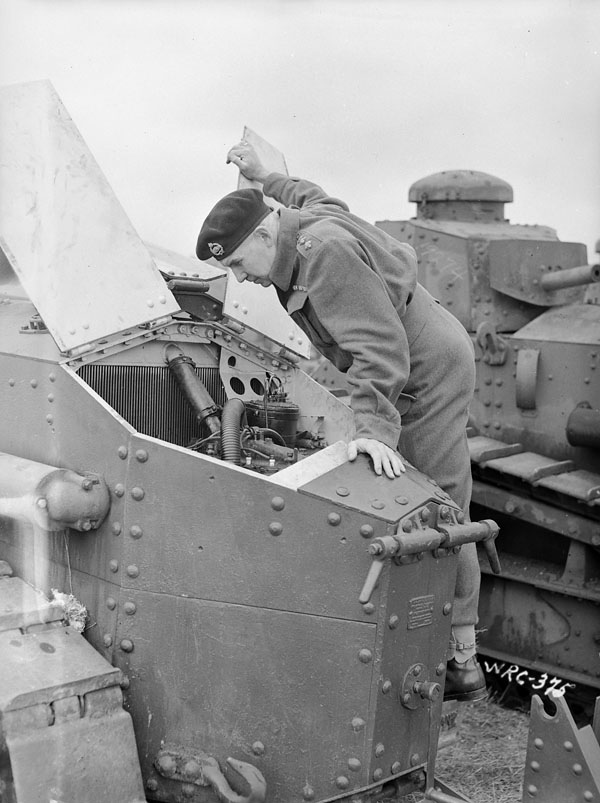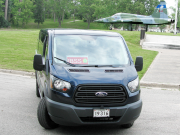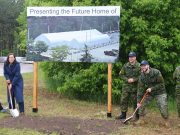
By / Par Leighsah Millward, Citoyen Borden Citizen
Worthington Park is not only a beautiful place to take a walk, but also a place to explore with tanks from many different eras on display. Perhaps you might have wondered who this Worthington was, and what he had to do with all these tanks.
Major-General Frederic Frank “Fighting Frank” “Worthy” Worthington is the father of the Canadian Armoured Corps. Born in Scotland in 1889, Worthy found himself orphaned by the age of 11. Sent to live with a half brother in Mexico, he was on his own by age 14, adopting the life of a mercenary. By 1915, Worthington decided to return to his homeland, traveling to Montreal to join the Scottish Black Watch and without realizing, ending up in the Canadian Black Watch; automatically making him a Canadian.
Worthington began making a name for himself, his mercenary experience serving him well as a British solider. In 1916, Worthington saw tanks used in battle for the first time at the Battle of Somme and realized the potential of these mechanized fighting machines, which had the ability to maneuver in the thick barbed wire and trenches of “No Man’s Land.” In 1918, he witnessed an Austrailian victory at Amiens thanks to the “whippet” tank, and he was inspired to make history. Forming the Canadian Tank Corps using British and French tanks, they joined the war late and fought until November 1918, when the armoured units were disbanded.
Another European conflict looming in 1936 again brought the tank idea to the forefront, and Worthy was the obvious candidate to command the first Canadian Tank School, founded in London, Ontario. Lack of space moved both Worthy and the school to Camp Borden in 1938, where it was renamed several times before becoming the A-33 Canadian Armoured Corps Training Establishment.
A lack of equipment was the first challenge. Worthington noted the Americans were disposing of a number of new condition 1917 French Renault tanks, scooped them up and had them shipped to Canada. As the US was neutral at the time, and could not officially sell arms, Worthy had the tanks shipped as “scrap metal” to the Camp Borden “foundry” and started training men to use them. The School had a brief rocky period but eventually its worth was seen and two more Schools opened. The Meaford Armoured Fighting Vehicle Range was opened in 1942 to allow range facilities for the School, and the area’s Grey and Simcoe Foresters were trained as an Armoured Regiment until 1943. By the end of World War II, over 20,000 soldiers had trained in tank warfare at Camp Borden.
Worthington retired from the military in 1948, maintaining his association with the Armoured Corps. In 1949, the Royal Canadian Armoured Corps School at Borden designated him Colonel Commandant. Worthy held this position until his death in 1967, his body returning home to Borden, where it is interred to this day on the hill overlooking his beloved tanks.
Sources www.militarybruce.com, wikkipedia, Base Borden Military Museum
Digne de son nom
Le parc Worthington est un lieu magnifique où les visiteurs peuvent non seulement se promener, mais aussi explorer les chars datant de diverses époques qui y sont exposés. Vous vous êtes peut être demandé qui ce Worthington pouvait bien être et quel rapport il pouvait avoir avec tous les chars exposés.
Le major général Frederic Frank « le combattant » « Worthy » [« digne »] Worthington est le père du Corps blindé canadien. Né en Écosse en 1889, Worthy devient orphelin à 11 ans. Envoyé chez son demi frère, au Mexique, et laissé à lui même à 14 ans, il devient mercenaire. En 1915, Worthington décide de retourner dans son pays natal. Parti de Montréal pour rejoindre le Black Watch, un régiment écossais, il s’enrôle par inadvertance dans le Black Watch du Canada et obtient donc automatiquement le statut de citoyen canadien.
Fort de son expérience de mercenaire, qui lui est bien utile en tant que soldat britannique, Worthington commence à se bâtir une réputation. En 1916, voyant pour la première fois des chars employés au combat, durant la bataille de la Somme, il comprend le potentiel que présentent ces machines de combat mécanisées, qui peuvent passer à travers une grande épaisseur de fils barbelés et dans les tranchées du « no man’s land ». En 1918, il est présent lorsque les Australiens remportent la victoire à Amiens grâce au char « whippet », et il sent le désir de marquer l’histoire. Établi et mis à contribution vers la fin de guerre, le Corps de chars canadien, qui compte des chars de l’armée britannique et de l’armée française, combat jusqu’en novembre 1918, moment où les unités blindées sont dissoutes.
En 1936, l’imminence d’un nouveau conflit ravive l’idée d’exploiter des chars. Worthy est la personne toute désignée pour commander la première école canadienne de manœuvre de chars, fondée à London, en Ontario. En 1938, Worthy et l’école se retrouvent au Camp Borden en raison du manque d’espace à London. L’école change de nom à plusieurs reprises avant de devenir l’Établissement A 33 d’entraînement du Corps blindé du Canada.
La première difficulté est le manque d’équipement. Se rendant compte que les Américains se débarrassent d’un certain nombre de chars en bon état, des Renault fabriqués par les Français en 1917, Worthington prend les chars et les expédie au Canada. Les États Unis étant neutres à l’époque et ne pouvant donc pas officiellement vendre des armes, Worthy expédie les chars à la « fonderie » du Camp Borden en indiquant qu’il s’agit de « tas de ferraille », puis il commence à entraîner des soldats à les utiliser. L’école passe par une brève période d’instabilité, mais sa valeur finit par être reconnue, et deux autres écoles sont fondées. Le Polygone de Meaford pour véhicules blindés de combat ouvre en 1942, ce qui permet à l’école de bénéficier d’installations de tir et aux membres du Grey and Simcoe Foresters des environs de s’y entraîner en tant que régiment blindé jusqu’en 1943. À la fin de la Deuxième Guerre mondiale, plus de 20 000 soldats auront suivi au Camp Borden l’entraînement requis pour combattre à l’aide de chars.
Worthington prend sa retraite de l’armée en 1948 et reste en relation avec le Corps blindé. En 1949, l’École du Corps blindé royal canadien de la BFC Borden lui accorde le titre de colonel commandant. Worthy conservera ce titre jusqu’à son décès, en 1967. Ramenée à la BFC Borden, sa dépouille est enterrée sur la colline qui donne sur les chars que Worthy a tant aimés.
Sources : www.militarybruce.com, Wikipédia, Musée militaire de la BFC Borden










